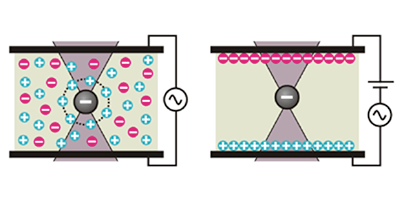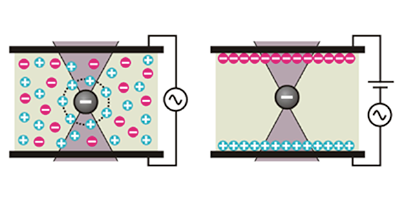Stripping Away Confusion
Electric-field-induced motion of particles in a fluid is surprisingly complex. It arises from a combination of direct electrostatic forces, fluid friction, and a retardation force caused by electric fields acting on ions that form a diffuse layer around the particle. Understanding this motion, called electrophoresis, is important for applications as diverse as DNA analysis, nanofluidics, and the electronic ink in e-readers. But conventional measurements of the retardation force is difficult and requires strong electric fields that may cause gas formation or heating that interferes with the experiment. In Physical Review X, Filip Strubbe of Ghent University, Belgium, and colleagues report a different approach to measuring the retardation force with small fields to test theories of electrophoresis.
Strubbe et al. studied single, micron-sized polymer particles dispersed in a mixture of nonpolar solvent and surfactant. This arrangement is known to create a diffuse layer of charges around each particle. The authors used a laser to trap a single particle between transparent electrodes, and monitored its mobility with a camera. The researchers applied a small electric field to the solution, which removed all charge carriers and thus eliminated the charged layer around the particle. Comparing the mobility with and without this diffuse “double layer” allowed them to obtain the retardation caused by these charges.
The authors found that although their results agree well with present theories of electrophoresis, there are some deviations that partly arise from assumptions used in the analysis. However, the results also explain some unexpected particle accelerations that occur near the electrodes of e-ink displays. As a result, it may be possible to improve the switching speed and the quality of the displayed images. – David Voss





